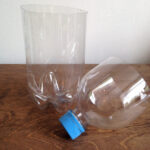A study by the UK’s National Sanitation Foundation found that 32% of kitchen countertops are contaminated with coliform bacteria, the type found in human and animal waste. This can lead to illnesses and infections, including food poisoning. And it’s not the only bacteria lurking where you prepare your food.
From cheese graters to air fryers, experts say these are the six dirtiest spots in your kitchen and reveal how to clean each appliance to reduce bacteria levels and lower the risk of illness.
Here are the kitchen tools with the highest bacteria count:
1. Blenders and Air Fryers
When blending sauces or smoothies, make sure to clean your blender thoroughly. A study by the National Sanitation Foundation found that blenders are the “third germiest” among various kitchen appliances, harboring bacteria such as salmonella, E. coli, yeast, and mold.
To properly clean a blender, Dr. Emilia Pasiah, a family medicine specialist, advises: “Immediately after use, fill the blender halfway with warm water and add a drop of soap. Turn the blender on low for 30 to 60 seconds to dislodge food particles. Then, disassemble the blender and wash each part separately by hand in hot, soapy water.”
“Use a soft brush or toothbrush to clean around the blades and any hard-to-reach areas. Then, rinse each part under hot running water to remove soap residue and let all parts air dry.”
For air fryers, Dr. Pasiah says that bacteria thrive in the machine’s basket. “Old oil can turn rancid, causing unpleasant odors and even mild food poisoning symptoms such as stomach aches and nausea.”
Clean your air fryer after each use, once it has cooled down. Soak the basket and tray in hot, soapy water and use a soft brush or sponge to scrub away any food residue.
“To clean the inside of the air fryer, wipe it down with a damp cloth and a small amount of soap. A vinegar solution (one part vinegar to three parts water) can help remove greasy buildup,” says Dr. Pasiah.
2. Salt and Pepper Shakers

Salt and Pepper Shakers
Think about how many people handle the salt and pepper shakers daily. “These are probably one of the germiest items in your kitchen,” says Dr. Tang.
“Bacteria such as Staphylococcus aureus and viruses from handling raw meat or being near someone who is sick can easily spread to these shakers as they are passed around the table”, adds Dr. Pasiah.
Try to disinfect the salt and pepper shakers regularly with antibacterial wipes, ensuring you focus on the top areas that come into contact the most.
3. Mugs and Cups
You might think a quick rinse is enough to clean your tea mug, but Dr. Pasiah says, “The real issue lies in the biofilm – essentially a layer of bacteria that can grow inside the mug, especially if it contains liquids like coffee or milk.”
Bacteria such as Staphylococcus aureus and E. coli can survive on surfaces for several days, so use hot water, soap, and a sponge or clean brush to wash them thoroughly, and air dry to avoid transferring bacteria from a towel.
4. Refrigerator
The cold temperature in your fridge doesn’t mean food is safe from bacteria – research has found that some microorganisms, including bacteria, molds, and yeasts, can grow or survive at 4 degrees Celsius, the average kitchen fridge temperature.
For example, these microorganisms from contaminated raw foods can be transferred to fridge surfaces from your hands or leak from packages. They can then contaminate other foods in the refrigerator.
“Thoroughly clean your refrigerator every one to two months by removing all food, wiping down the shelves with a mild detergent or vinegar solution, ensuring you clean up any spills or leaks. Pay special attention to the drawers, where bacteria can easily accumulate. Don’t forget the door handles, one of the most frequently touched surfaces that can harbor bacteria,” advises Dr. Pasiah.
5. Sponges and Dishcloths
These are the items you use for cleaning, but be aware that they can also harbor and spread a significant amount of bacteria.
In a study, 49% of dishcloths collected from household kitchens tested positive for bacterial growth.
The bacteria included coliform bacteria; enterococcus spp., which can cause urinary tract and abdominal infections; and Staphylococcus aureus, which can lead to skin and blood infections.
The Food and Drug Administration (FDA) recommends regularly replacing dishcloths and avoiding using them for multiple purposes, such as wiping hands as well as dishes and drying surfaces as well as ceramics.
As for kitchen sponges, they can harbor bacteria such as E. coli, salmonella, and listeria. It might be wiser to discard them and switch to brush washers, as studies show they contain fewer bacteria than sponges.



































